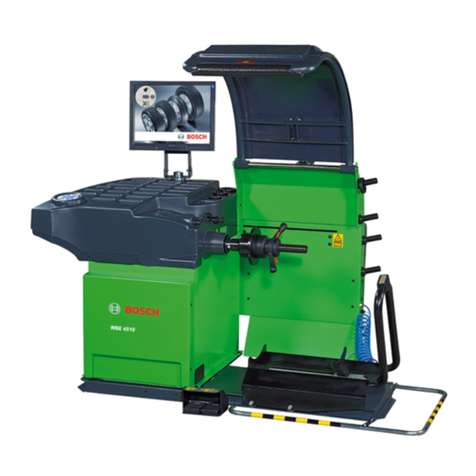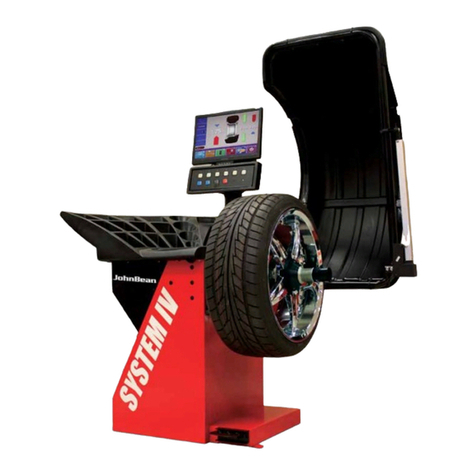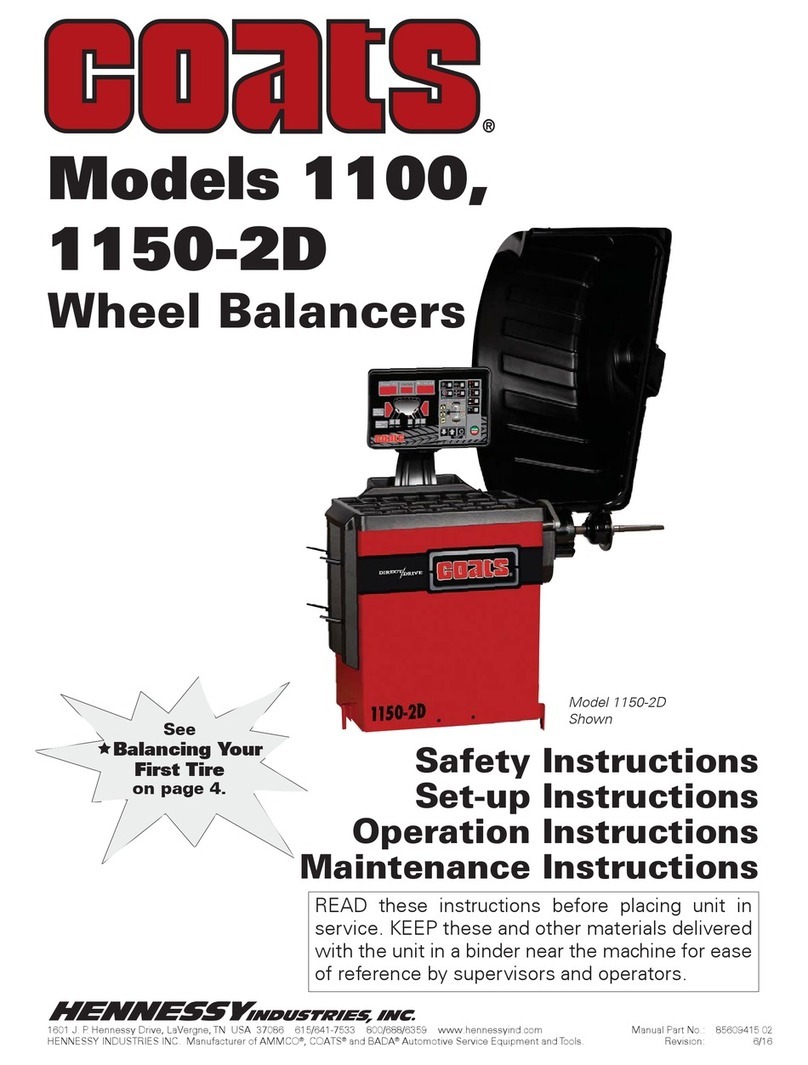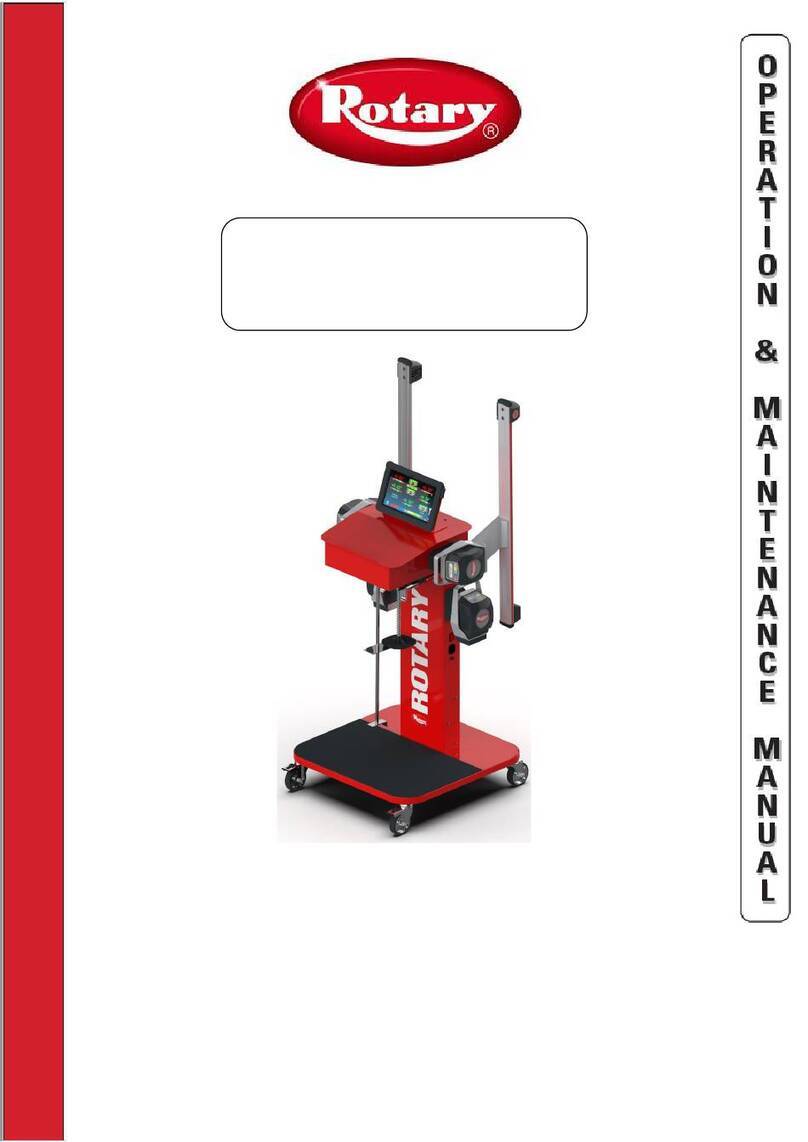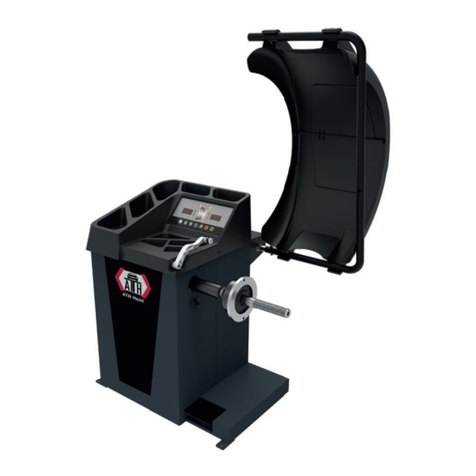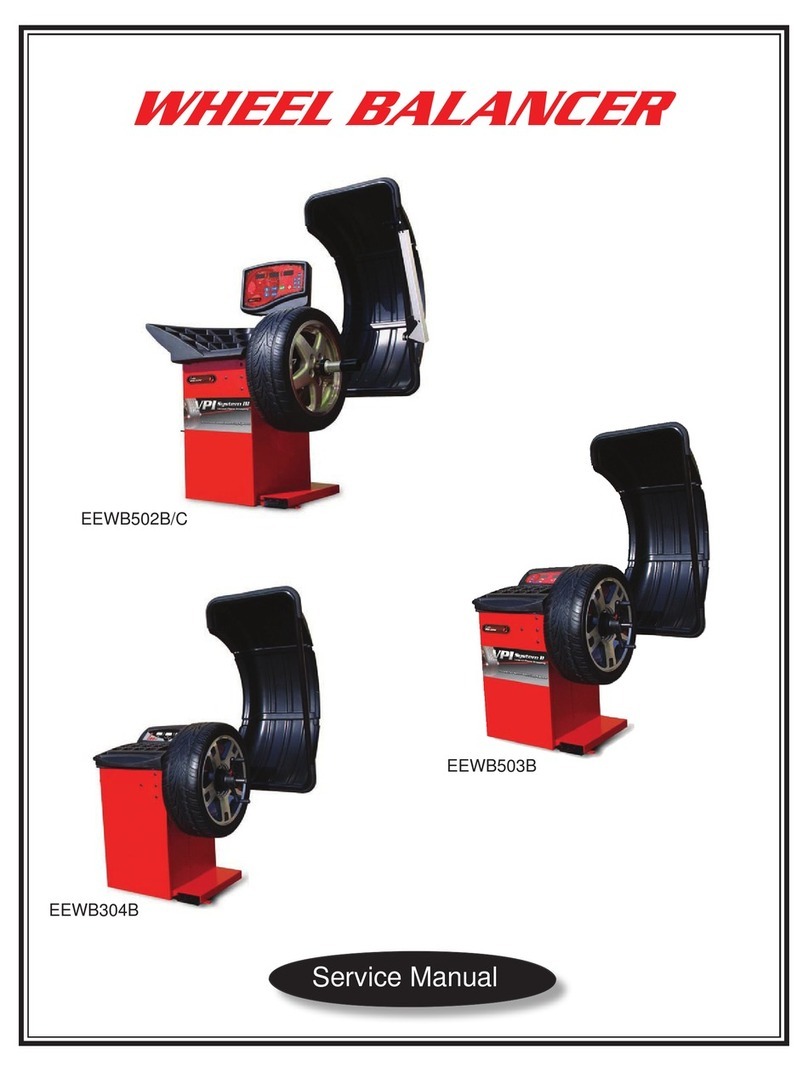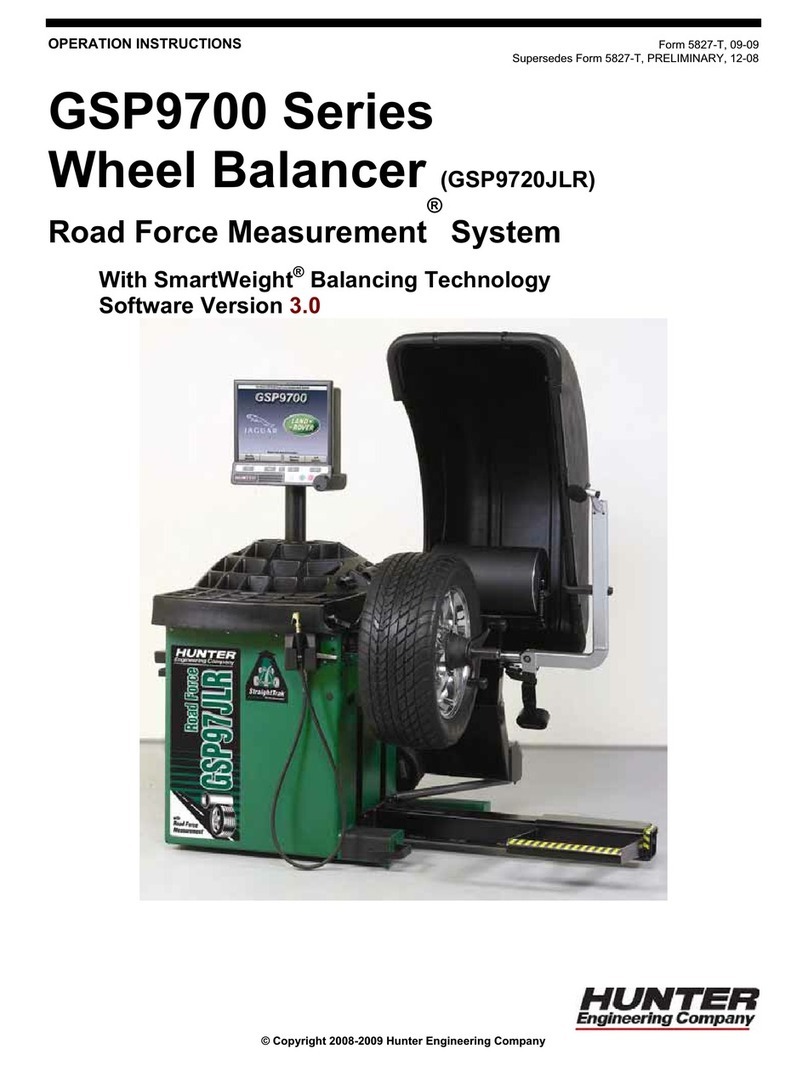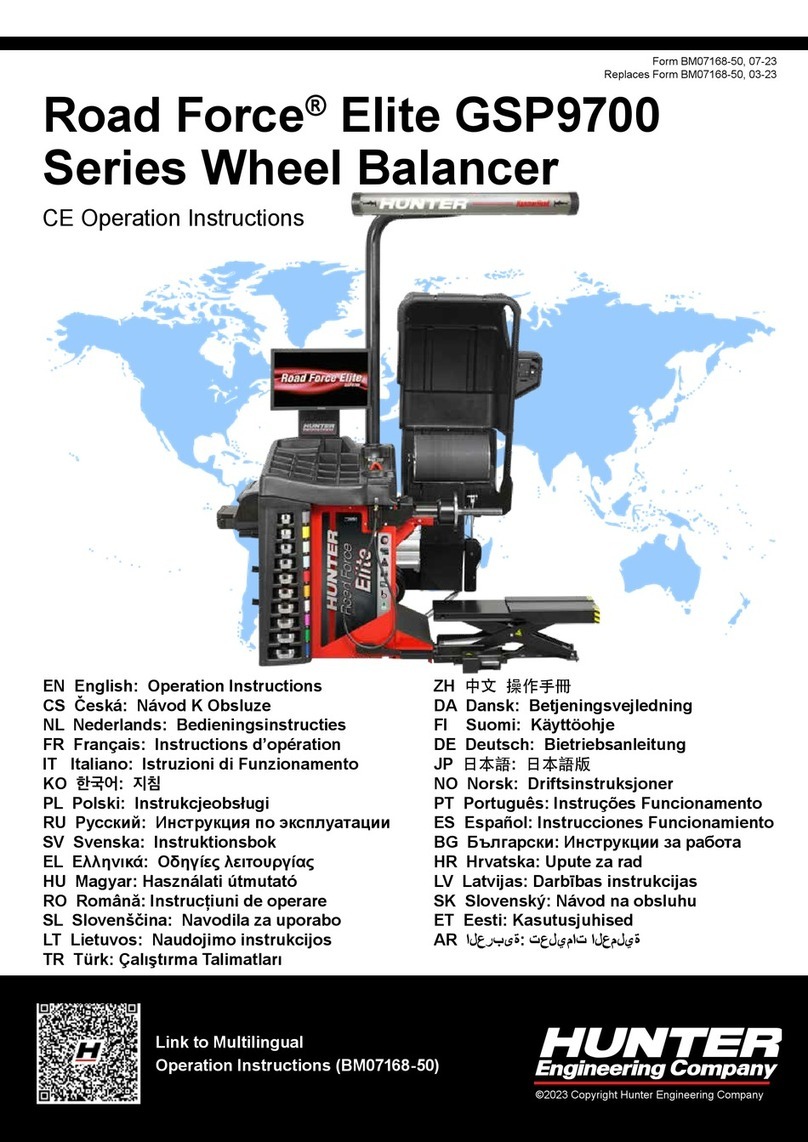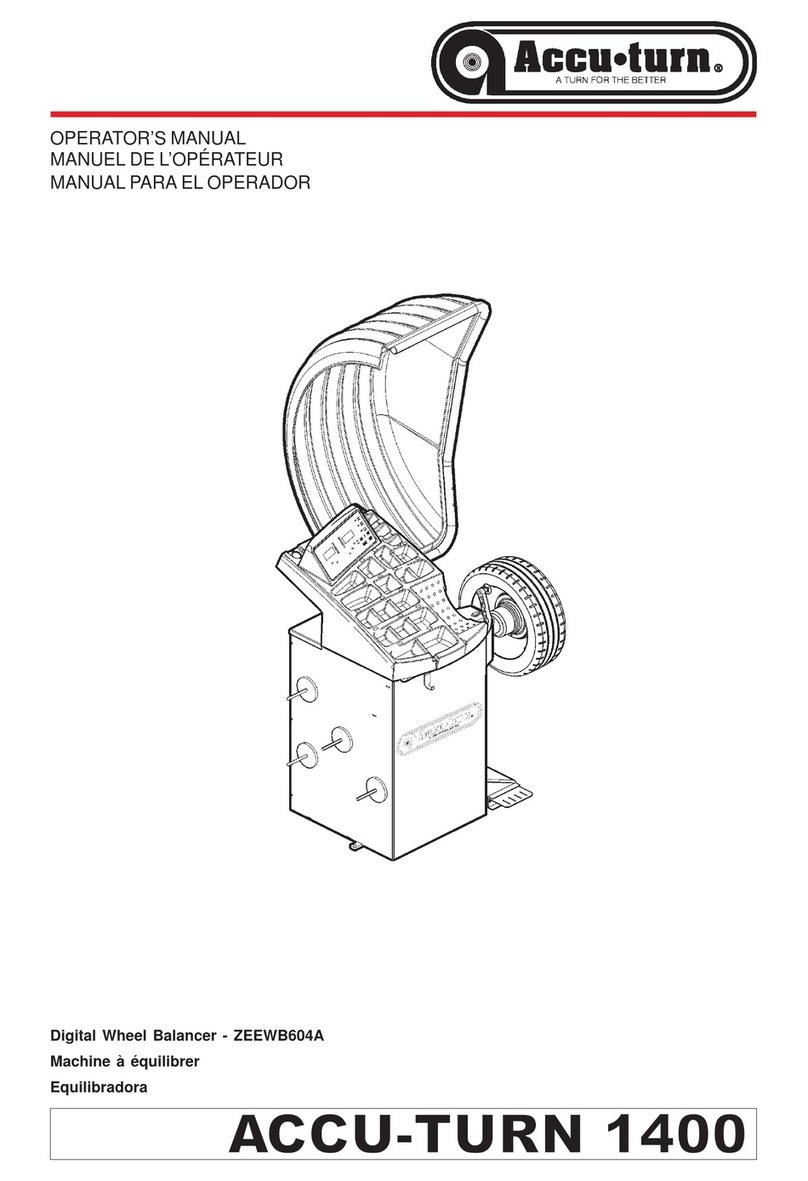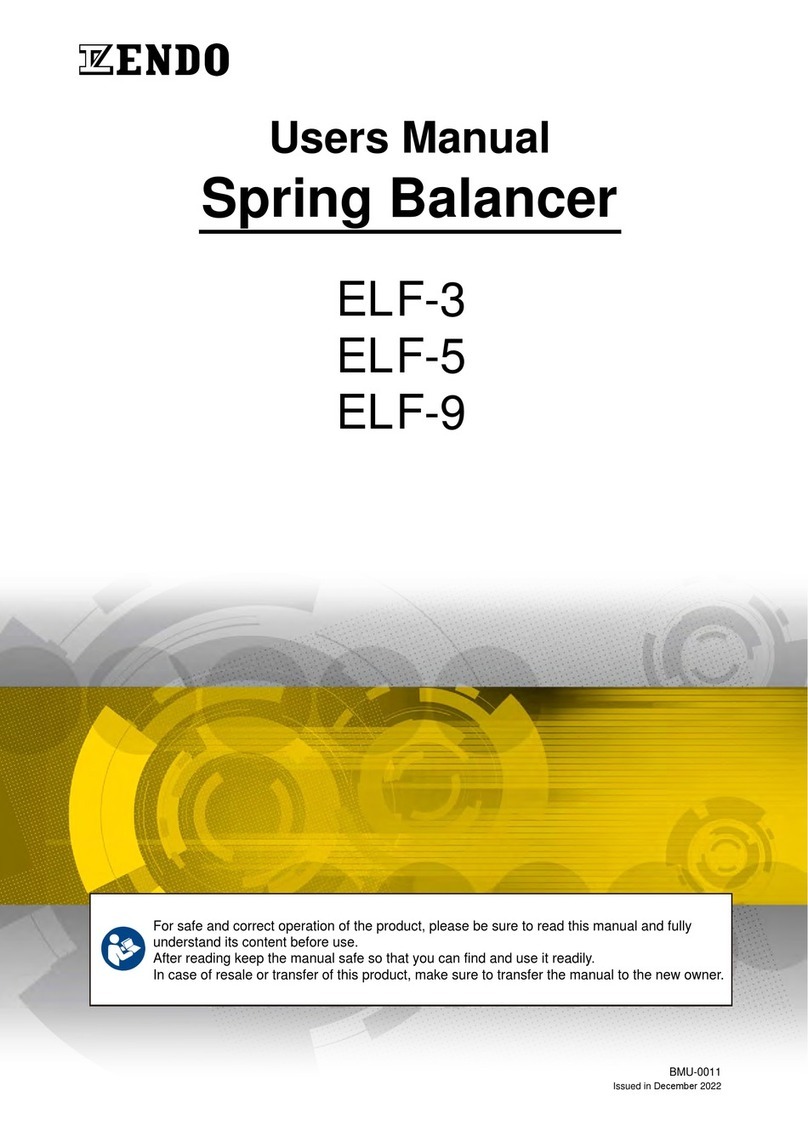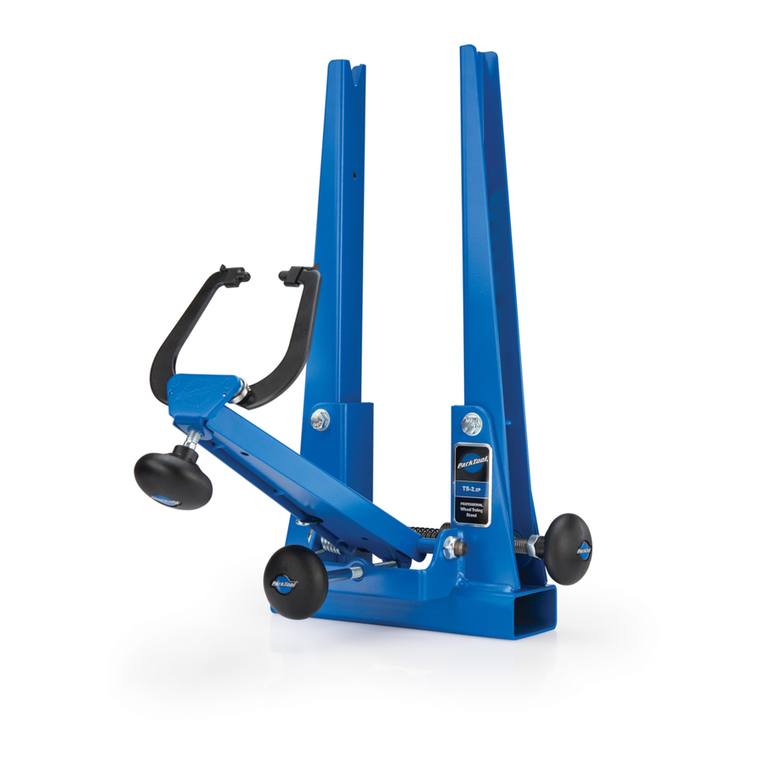nor-tec WB300N User manual

0
Wheel Balancer Manual
Nortec WB300N

1
Warning
This manual is a necessary part of the product. Please read carefully.
Keep the manual for later use when maintaining the machine.
This machine can only be used for the designated purposes. Never use it for any other purpose.
The manufacturer is not responsible for the damage incurred by improper use or use other than the
intended purpose.
Precaution
The equipment can only be operated by qualified personnel with special training. Modification to any
components or parts, or use the machine for other purpose without either obtaining the agreement from the producer,
or observing the requirement of the instructions may lead to direct or indirect damage to the equipment.
★The equipment should be installed on the stable ground, not wooden pallet, otherwise not accurate.
Keep the back panel 0.6M away from the wall for good ventilation. Enough room should be left on both
sides for convenient operation.
Do not put the equipment a place with high temperature or moisture, or near the heating system, water tap,
air-humidifier or chimney.
Avoid lots of dust, ammonia, alcohol, thinner or spraying binder.
People who are no operating the machines should be kept away when it is used.
Use appropriate equipment and tools, protective and safety equipment, including eyeglasses, earplugs and
working boots.
Pay special attention to the marks on the machine.
Do not touch or approach the moving parts by hand during operating.
Do not remove the safety device or keep it from working properly.

2
Contents
1. General-----------------------------------------------------------------------------------------------------------------1
2. Machine assembly----------------------------------------------------------------------------------------------------1
3. Controls and components--------------------------------------------------------------------------------------------3
4. Indication and use of wheel balancer------------------------------------------------------------------------------6
5. Self-calibration ofwheel balancer -----------------------------------------------------------------------------10
6. Errors------------------------------------------------------------------------------------------------------------------11
7. Self-diagnoses-------------------------------------------------------------------------------------------------------12
8. Setting machine------------------------------------------------------------------------------------------------------12
9. OPT function --------------------------------------------------------------------------------------------------------13

1
1. General
1.1. Technical data:
Max wheel weight:70kg
Power:0.25kw
Power supply: 220v; 50-60hz
Balancing accuracy:
±
1g
8 balancing modes: DYN, ALU1, ALU2, ALU3, ALU4,ALU5,ALUS, ST
Balancing speed:200r/min
Cycle time:8s
Rim diameter:10〃~24〃(256mm~610mm)
Sound pressure level during work cycle:<70db
1.2. Features:
Statistic and dynamic balancing,ALU-programs for alloy rims or special shaped
ALU balancing mode may choose 6 o’clock or 12 o’clock position to add weight
Self diagnoses, easy to find the problem
Apply to steel and aluminum alloy rim
1.3. Working environment:
Temperature:5~50℃
Height:≤4000m
2.Machine assembly
2.1. Unpack
Unpack the carton, check if missing any spare parts.
No. Item Qty
1 Width gauge 1
2
Conic No.1 1
Conic No.2 1
Conic No.3 1
Conic No.4 1
3 Quick relase nut 1
4 Thread hub 1
5 Bowl for quick nut 1
6 Pad for bowl 1
7 Balancing hammer 1
8 100g weight 1
9 Allen wrench 1

2
2.2. Install
The equipment should be installed on the stable ground, not wooden pallet, otherwise not accurate.
Keep the back panel 0.6M away from the wall for good ventilation. Enough room should be left on both
sides for convenient operation.
2.3. Fix balancer to floor with screws on the bottom.
2.4. Install adaptor
The wheel balancer is supplied complete with cone type adaptor for fastening wheel with central bore. (see below
picture)
2.5. Install wheel
Clean wheel, take off counterweights, check pressure of wheel.
Choose the way of installation according to the type of wheel.

3
Main shaft-wheel—Main shaft-suitable cone(big head towards inside)
suitable cone( small head towards inside)—quick handle nut —wheel—quick handle nut
Attention:May add a wheel, and hold the wheel to help install the thread hub. When installing or taking off
wheel, do not let wheel move on the shaft, to avoid scratching shaft.
3.Controls and components
No. Item
Standard/Optional
A Switch S
B Head with
tool tray S
C Gauge head S
D Main shaft S
E Pedal
breaker O
F Safe guard S
G Key board S

4
Display plate (G)
1.inside unbalance value digital display
2.inside unbalance position display
3.outside unbalance value digital display
4.outside unbalance position display
5.displays showing type of correction chosen.
Eight balancing modes
Icon
Balancing
mode
Operation Add weights
Standard/Default
1. Turn on machine
2. Input a,b,d value
3. Start spin, after spin stop
Clip on weights on
both sides of rim edge
ALU1
1. Turn on machine
2. Input a,b,d value
3. Press ALU button, indicator lit up
4. Start spin, after spin stop
Add adhesive weights
on the rim shoulder
both sides
ALU2
1. Turn on machine
2. Input a,b,d value
3. Press ALU button, indicator lit up
4. Start spin, after spin stop
Clip on weight on
inside rim edge, add
adhesive weight on
outside rim shoulder
ALU3
1. Turn on machine
2.Input a,b,d value
3.Press ALU button, indicator lit up
4.Start spin, after spin stop
Add adhesive weights
on the rim shoulder
both sides
ALU4
1. Turn on machine
2. Input a,b,d value
3. Press ALU button, indicator lit up
4.
Start spin, after spin stop
Clip on weight on
inside rim edge, add
adhesive weight on
outside rim shoulder

5
ALU5
1. Turn on machine
2. Input a,b,d value
3. PressALU button, indicator lit up
4. Start spin, after spin stop
Add adhesive weight
on inside rim shoulder,
clip on weight on
outside rim edge
ALUS
1. Turn on machine
2. PressALU button, indicator lit up
3. Input aI,aE,d value
4. Start spin, after spin stop
Add adhesive weights
on the two positions
gauge head touch
Static mode
1. Turn on machine
2. Input a,b,d value
3. Press ALU button
4. Start spin, after spin stop
Add adhesive weight
Pay attention to the position of unbalanced lead block according to the setting
LAS=OFF
LAS=ON
inside
Balancing mode
outside
inside
Balancing mode
outside
12
o’clock
12
o’clock
12
o’clock
12
o’clock
12
o’clock
12
o’clock
6
o’clock
6
o’clock
12
o’clock
12
o’clock 12H 6
o’clock
12
o’clock
12
o’clock
6
o’clock
12
o’clock
12
o’clock
12
o’clock
12
o’clock
12
o’clock
12
o’clock
12
o’clock
6
o’clock
12
o’clock
Gauge
head
Gauge
head
6
o’clock
6
o’clock
12
o’clock
12
o’clock
12
o’clock
12
o’clock

6
Key board (H)
Icon Function Icon Function
Rim data
Selection of “ALU” modes
Data add key
Unbalance display pitch and threshold
Data reduction key
Start
Stop/Cancel
*Electronic brakes *
Icon
Function
Icon
Function
Automatic brake switch / can be used
to load and unload tires
Search for location
4. Indication and use of wheel balancer
4.1.DYN (Standard/Default) mode
4.1.1. Clean wheel, take off counterweights, check pressure of wheel.Choose the way of installation according to the
type of wheel.
Main shaft-wheel—Main shaft-suitable cone(big head towards inside)
suitable cone( small head towards inside)—quick handle nut —wheel—quick handle nut
Attention:May add a wheel, and hold the wheel to help install the thread hub. When installing or taking off
wheel, do not let wheel move on the shaft, to avoid scratching shaft.
4.1.2. Turn on machine

7
4.1.3. Input a b d value
Turn on machine, choose right way to install wheel according to the type of wheel. Set “a” “b” “d”
values:
● set “a” value:move the gauge to measuring position as illustrated as Fig.1, hold the gauge still in
position for approx. 4 seconds, successful memorization is given, then return the gauge to position
0.(The value measured in automatic mode appear on the display). Or press and and to set
manually.
● set “b” value:set nominal diameter “b” marked on the wheel or use the width gauge to measure the
value of ”b” as Fig.2, then press and and to set manually.
● set “d” value:this value measured in automatic mode same time as “a” value setting, or press and
and to set manually.
Fig.1 Fig.2
4.1.4. Put down the guard and press to perform a measuring spin.
4.1.5. In a few seconds the wheel is brought to operating speed and begin measuring unbalance, the unbalance values
remain on instruments 1 and 3 when the wheel stopped. Press may check the real unbalance value under threshold.
4.1.6.Anticlockwise moving wheel slowly, until the right LED lit up full, clip weight on 12 o’clock position (Fig.3)
Fig. 3
4.1.7.Anticlockwise moving wheel slowly, until the left LED lit up full, clip weight on 12 o’clock position (Fig.4)

8
Fig. 4
4.1.8.After finishing cliping the counterweights, put down the guard or press ,to perform balancing spin
again, if comes out 00 00,means balancing succeed. (Fig.5)
Fig. 5
4.2.ALU-1 mode (ALU-1,ALU2 same operation, only the position to add weights different)
4.2.1. Set “a” “d” “b” values
4.2.2. Press until ALU1 indicator lit up
4.2.3. Put down the guard and press to perform a measuring spin.
4.2.4. In a few seconds the wheel is brought to operating speed and begin measuring unbalance, the unbalance values
remain on instruments 1 and 3 when the wheel stopped. Press may check the real unbalance value under threshold.
4.2.5. Anticlockwise moving wheel slowly, the displays with right LED’s lit up full indicate the correct angular position
where to mount the counterweights, (las=on,las=off) position outside, as Fig.6, add the counterweight.
Fig. 6
4.2.6. Anticlockwise moving wheel slowly, the displays with left LED’s lit up full indicate the correct angular position
where to mount the counterweights, (las=on,las=off) position inside, as Fig.7, add the counterweight.

9
Fig. 7
4.2.7. After finishing mounting the counterweights, put down the guard and press ,to perform balancing spin
again, if comes out 00 00,means balancing succeed. (Fig.8)
Fig. 8
4.3.ALU-S mode
This mode is used for special rim, ifALU1/ALU2 can not be used, you should choose ALUS mode.
Input aI, aE, d value
Set “aI”: pull gauge out let the gauge head touch the position of FI for 4 seconds, may press and and
to change
Set “aE”: pull gauge out let the gauge head touch the position of FE for 4 seconds ,may press and and
to change
Set “dI”: read from rim, may press and and to change
Set “dE”: read from rim, may press and and to change
Fig. 9

10
Put down the guard and press to perform a measuring spin.
4.3.1. 6 o’clock position to add weight
Set (las=on) according to 10.1
Anticlockwise moving wheel slowly, until the right LED lit up full, add weight on 6 o’clock position (Fig.10)
Fig. 10
Anticlockwise moving wheel slowly, until the left LED lit up full, add weight on 6 o’clock position (Fig.11)
Fig. 11
After finishing mounting the counterweights, put down the guard and press ,to perform balancing spin again, if
comes out 00 00,means balancing succeed. (Fig.12)
Fig. 12
4.3.2. Use gauge head to add weight
Set (las=off) according to 10.1
Fig. 13
Anticlockwise moving wheel slowly, until the right LED lit up full (Fig.14)

11
Fig. 14
Take off proper counterweight to be hold by the gauge head as Fig. 16
Fig. 15 Fig. 16
Pull out gauge until there is a square comes in the middle window (Fig. 17)
Fig. 17
Release the counterweight and let it stick on rim (Fig. 18)
Fig. 18
Anticlockwise moving wheel slowly, until the left LED lit up full (Fig.19)
Fig. 19
Take off proper counterweight to be hold by the gauge head as Fig. 16
Pull out gauge until there is a square comes in the middle window (Fig. 20)

12
Fig. 20
Release the counterweight and let it stick on rim (Fig. 21)
Fig. 21
Then turn down safe guard and press to start spin, comes Fig. 22 means the wheel is balanced.
Fig. 22
3.4 ALUS split function
Note: OnlyALU-S mode can use this function. And Operator must be experienced.
1 In the case of theALU-S mode, press comes>
2
Through the and input wheel number, then
press
comes>
3
Keep the next spock( either direction is ok) on the position
of (las=on,las=off) press comes>
4
Anticlockwise rotate wheel by hand slowly, until the
outside SP1 LED lit up full, add the adhesive weight(to
stick the weights on position of (las=on,las=off)
comes>

13
5
Anticlockwise rotate wheel by hand slowly, until the
outside SP2 LED lit up full, add the adhesive weight(to
stick the weights on position of (las=on,las=off)
comes>
6 Put down safe guard and press ,after spin stop
Successful operation
5.Self-calibration of wheel balancer
5.1. Self-calibration of wheel balancer
5.2.Turn on balancer, install a medium size wheel (14″-18″)which can use clip-on weight, set “a b d” value, then
Do the self-calibration whenever you think the balancer is not accurate. The 100g weight must be accurate.
Step 1 Press and hold, then press comes
Step 2 Put down safe guard or press start spin, after spin stop comes
Step 3
Open the safe guard and clip a 100 gram weight on the outside
12 o’clock position, put down safe guard and press to start
spin, after spin stop
comes
Step 4
Open the safe guard and clip a 100 gram weight on the inside 12
o’clock position, put down safe guard and press to start
spin, after spin stop
comes
self-calibration finished
6.Rim distance gauge calibration
+comes>
pull gauge to position “0” and hold, press comes>

14
pull gauge to position “15” and hold, press comes>
Set “d” by press and , (for example if it is 16 inch,
make it 16)comes>
move gauge to touch the edge of rim and keep still
>press
comes>
self-calibration finished
7. 1 Width gauge calibration (if provided)
1 +omes>
2 explain
>Keep the shield in position
3 Auto complete omes>
Width gauge calibration finished

15
7.2 width compensation
Tire installation required note (known tire width)
1 A value must be entered explain
>
2 We're aiming the radar at the tires explain
>
3 explain
>Press +or at the same time
to modify the known tire width
Put down the key to save automatically
8. Errors
Various abnormal conditions can arise during machined operation by the microprocessor, if comes the errors, must stop
operation, find the reason and the solution according, if the error persists, consult the supplier.
No. Errors Reasons Solution
1 1.No spin
2.Shaft spin
1.If no spin, check or c
hange power
board
2.If spin, check or change position pick
up board and computer board
3. Adjust position pick up board support
2
1
.
No wheel or wheel not locked
tightly
2.
Position pick up board
problem
1.Lock tightly
2. check or change position pick up
board
3 1.No enough pressure in wheel
2.Wheel distortion
1.Add proper pressure in wheel
2.Check wheel

16
4
1.Position pick up board
problem
2. Computer board problem
1.C
heck or change position pick up
board
2.Check or change computer board
5 1. Micro switch problem
2.Computer board problem
1.Check or change Micro switch
2.Check or change computer board
6 1. Power board problem
2. Computer board problem
1.Check or change power board
2.Check or change computer board
7 1. Program lost
2. Computer board problem
1.Self calibration
2. Check or change computer board
8
1. No add 100g weight during
self calibration
2.Computer board problem
3.Power board problem
1. Add 100g weight
2.Check or change computer board
3.Check or change power board
9 1.Micro switch problem
2. Computer board problem
1.Check or change m
icro switch
2.Check or change computer board
10 1.Computer board problem
2.Power board problem
1.C
heck or change computer board
2.Check or change Power board
9. Self- diagnoses
Press and hold, then press goest to self diagnoses, press to next , press to escape
Order Display Function Function normal
1 Display All lit up
2 Position pick up board POS changes in 0-127
3 Distance potentiometer Left window data is 327-340, when pull gauge out,
the data changes
4 Diameter potentiometer left window data is 327-340,
turn ruler to another
direction, data changes
5 Width potentiometer left window data is 0-600,
Cover the sensor with
your hand

17
6 Pressure sensor Use hand to press main shaft, 4X-4X 6X-6X
changes
10.Setting machine
10.1.Machine setting
Press and hold, then press goes to set machine, press and to change,press to next
Order Display function choice
1 Unbalance display
threshold 5/10/15
2 Sound On/off
3 Light 1-8
4 Laser switch OFF: 12 o’clock
ON: Laser switch
5 Tire weight On/off
inch /mm ON:inch
OFF:mm
6 Safe guard
ON: Put down safe guard to start spin
OFF: Put down safe guard then press start to
start spin
Unit of weight Gram/ Ounce
8 Tire type operation CAr:car Boot display [CAr]
Sco:Motorcycle Boot display [Sco]
11.OPT function
Note: When unbalance value is too much, choose OPT, and operator must be experienced.
Install wheel, input a b d value
1 Press +comes>
Table of contents
